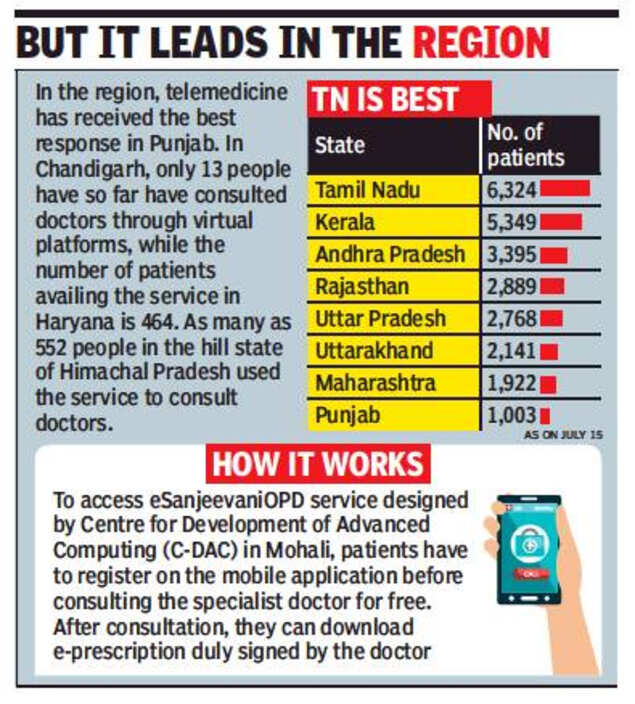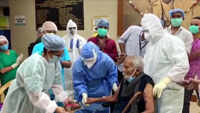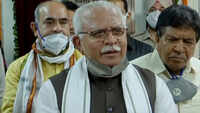
CHANDIGARH: Telemedicine consultation service, which has been started to provide remote diagnosis and treatment to minimise the risk of people getting infected by Covid-19, has received a lukewarm response in Punjab.
To serve patients and halt the spread of coronavirus, the World Health Organization (WHO) has laid emphasis on patients staying at home and communicating with physicians virtually. It has recognised telemedicine as an important step in strengthening the health system’s response to the pandemic.

Launched by the Punjab government on April 25 for general medicine and gynaecology, eSanjeevaniOPD service has managed to attract only 1,003 patients in 81 days. More than 12 patients availed the service on an average with collective consultation duration of 125 hours. Of the 250 doctors trained and enrolled for the service, half have not been consulted even once.
Infrastructural and technical hurdles and lack of awareness are seen as key reasons for the concept not picking up in Punjab, where 8,511 Covid-19 cases and 213 deaths had been reported till Tuesday.
A large population of the state does not have access to internet and computer\laptop. As per the data of National Sample Survey Office (NSSO) survey, only 9.4% households in rural areas of the state have computers, while 39.4% have internet connectivity. In urban areas, 26.7% households have computers, and 57.1% have access to internet.
Earlier, for availing the service, laptop/desktop with high speed internet connection was required. For increasing access, the state government on July 1 launched a mobile application, enabling patients to avail the service of teleconsultations using their smartphones. According to figures of Telecom Regulatory Authority of India (TRAI), 42.46% of population in rural areas has mobile internet connections.
To improve on this, the government is now planning to start the service on interactive voice response (IVR) calling. Once started, the reach of the service will widen substantially as Punjab has the second highest teledensity among all states in India at 121.41, while the national average is 93.98. Teledensity in Punjab is among the highest in both urban and rural parts of the state at 170.64 for cities and 81.84 in villages and towns, as per the TRAI data.
The service was also hit by limited timing, which has been extended. The timings for gynaecology and general OPD services have been extended from 8am to 2pm from Monday to Saturday.
Punjab health department nodal officer of eSanjeevaniOPD service Dr Deepinder Singh said required changes were being made to make the service more patient friendly. “There is also a need to generate awareness at the district level about the service,” said Dr Deepinder.
To serve patients and halt the spread of coronavirus, the World Health Organization (WHO) has laid emphasis on patients staying at home and communicating with physicians virtually. It has recognised telemedicine as an important step in strengthening the health system’s response to the pandemic.

Launched by the Punjab government on April 25 for general medicine and gynaecology, eSanjeevaniOPD service has managed to attract only 1,003 patients in 81 days. More than 12 patients availed the service on an average with collective consultation duration of 125 hours. Of the 250 doctors trained and enrolled for the service, half have not been consulted even once.
Infrastructural and technical hurdles and lack of awareness are seen as key reasons for the concept not picking up in Punjab, where 8,511 Covid-19 cases and 213 deaths had been reported till Tuesday.
A large population of the state does not have access to internet and computer\laptop. As per the data of National Sample Survey Office (NSSO) survey, only 9.4% households in rural areas of the state have computers, while 39.4% have internet connectivity. In urban areas, 26.7% households have computers, and 57.1% have access to internet.
Earlier, for availing the service, laptop/desktop with high speed internet connection was required. For increasing access, the state government on July 1 launched a mobile application, enabling patients to avail the service of teleconsultations using their smartphones. According to figures of Telecom Regulatory Authority of India (TRAI), 42.46% of population in rural areas has mobile internet connections.
To improve on this, the government is now planning to start the service on interactive voice response (IVR) calling. Once started, the reach of the service will widen substantially as Punjab has the second highest teledensity among all states in India at 121.41, while the national average is 93.98. Teledensity in Punjab is among the highest in both urban and rural parts of the state at 170.64 for cities and 81.84 in villages and towns, as per the TRAI data.
The service was also hit by limited timing, which has been extended. The timings for gynaecology and general OPD services have been extended from 8am to 2pm from Monday to Saturday.
Punjab health department nodal officer of eSanjeevaniOPD service Dr Deepinder Singh said required changes were being made to make the service more patient friendly. “There is also a need to generate awareness at the district level about the service,” said Dr Deepinder.

Coronavirus outbreak
Trending Topics
LATEST VIDEOS
City
 Watch: 101-year-old Mumbai man recovers from Covid-19, hospital staff celebrates his birthday
Watch: 101-year-old Mumbai man recovers from Covid-19, hospital staff celebrates his birthday  On cam: Drunk man falls into 100-feet-deep dilapidated well, rescued in Andhra Pradesh
On cam: Drunk man falls into 100-feet-deep dilapidated well, rescued in Andhra Pradesh  Love for photography: Man builds 3-storey camera-shaped house in Karnataka’s Belagavi
Love for photography: Man builds 3-storey camera-shaped house in Karnataka’s Belagavi  Kochi school teacher uses Augmented Reality Technology for conducting Lower Primary online classes
Kochi school teacher uses Augmented Reality Technology for conducting Lower Primary online classes
More from TOI
Navbharat Times
Featured Today in Travel
Quick Links
Kerala Coronavirus Helpline NumberHaryana Coronavirus Helpline NumberUP Coronavirus Helpline NumberBareilly NewsBhopal NewsCoronavirus in DelhiCoronavirus in HyderabadCoronavirus in IndiaCoronavirus symptomsCoronavirusRajasthan Coronavirus Helpline NumberAditya ThackerayShiv SenaFire in MumbaiAP Coronavirus Helpline NumberArvind KejriwalJammu Kashmir Coronavirus Helpline NumberSrinagar encounter
Get the app





